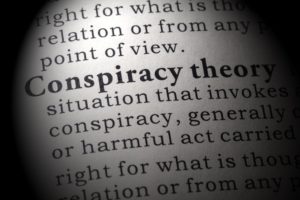Imagine if it’s good enough and Hillary Clinton leads a worldwide pedophile ring from a basement under a pizzeria, or if NASA actually controls the weather with secret technology from Area 51!

Conspiracy theories are so fun to read.
Despite the entertainment value, however, most of us are aware that silver paper hats may squeeze more than they benefit, and that conspiracy theories like these have little to do with reality.But can it be that the silver paper hats have never proved useful? We have decided to take a closer look at Ask Science.
Conspiracy theories can usually be dismissed as pure nonsense. But the conspiracy theories must have been right a few times, so the question is when and what is the story behind?
Rikke Alberg Peters, associate professor and PhD at HistorieLab, a researcher in conspiracy theories, and she has helped us answer the question.
Healthcare used blacks as guinea pigs
We can already reveal that the answer is yes, there are several examples of conspiracy theories that have proven true. And according to Rikke Alberg Peters, one of them is very current.
With a global pandemic of us have conspiracy theories glory days.
Theories of merciless and covetous pharmaceutical companies deliberately spread diseases to make money on medicine, namely a bit of a favorite of conspiracy theorists. Right now, Bill Gates in particular has ended up as the target .
But such absurd theories have not arisen out of nothing, says Rikke Alberg Peters.
“The syphilis experiment in Tuskegee, Alabama, is an insanely interesting example of a true conspiracy theory in light of the many theories about vaccines and diseases we are seeing right now with COVID-19.”
In 1930s Alabama, the U.S. health service conducted a series of experiments on 600 African-American men to study syphilis. Syphilis, which is a sexually transmitted infection, can result in, among other things, blindness, mental illness and death if left untreated.
The test subjects were told that they were receiving free treatment, but instead were lied to and given placebo medication. The men were to be used to observe how the disease developed untreated. At the given time, it was thought that the disease reacted differently by race.
The experiment continued until 1972.
“That is, the experiments continued after the penicillin came on the market after World War II. Thus, people who were infected with syphilis have not been treated, knowing about the major health risks and the possibility of infection, “says Rikke Alberg Peters.
This – one might well say – unethical experiment was first uncovered by journalists and researchers during the 1970s, who gained access to the documents and reviewed them from A to Z.
“It is a serious example of abuse of power and secrecy of information, which has led to great distrust of the health authorities – especially in the African-American communities in the United States, where it still resonates to this day.”
But if we are talking about true conspiracy theories, according to Rikke Alberg Peters, there is one we can not get around: the Watergate scandal.
“The Watergate scandal is a classic example of a case that began to be dismissed as a conspiracy theory with no team in reality, but which now stands as a milestone in modern American history,” says Rikke Alberg Peters.
Boiled down to a bouillon cube: On June 17, 1972, five burglars tried to break into the Democrats’ National Committee in the Watergate building in Washington DC
The burglars ‘mission to monitor the Democrats’ headquarters failed, and they were instead arrested with large amounts of cash on them.
The investigation continued, and President Richard Nixon attempted blackmail upon blackmail until he was finally put on trial. He ended up resigning as president.
“Watergate shows us how authorities can use the accusation that someone is just conspiracy theorists to conceal them and thus slow down a possible investigation. A trend we also see with the Trump administration today and the use of the term ‘fake news’, “says Rikke Alberg Peters.
A Polluted Concept
So have some conspiracy theories turned out to be true?
If you get a simple answer, it is not a researcher you have asked. Because even though the answer, as you know, is yes, the concept has a negative connotation, and therefore we often do not call them conspiracy theories when they turn out to be true.
Then we might call them ‘investigative journalism’ or ‘critical societal analysis’ instead.
‘When a term is used as an insult, its original meaning can very easily be lost. Especially after Trump came to power, it has become problematic to use the very word ‘conspiracy theory’. I mean, it is becoming a polluted concept – a power grab that you can connect to your political opponent, “says Rikke Alberg Peters.
‘In fact, I often myself use the term’ an alternative theory ‘because it is less stigmatizing and does not contain all the negative meanings that the concept of conspiracy has come to. Nor has an explanation been stamped as conspiracy theory in advance, even though it is emphasized that it rejects the official explanations. “











